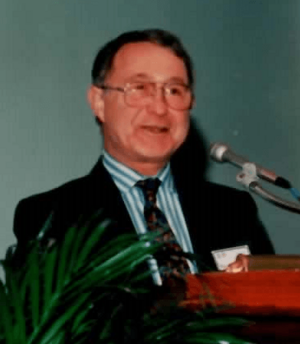James Freeman Gilbert facts for kids
Quick facts for kids
James Freeman Gilbert
|
|
|---|---|
 |
|
| Born | August 9, 1931 |
| Died | August 15, 2014 (aged 83) |
| Alma mater | MIT |
| Known for | Seismology |
| Spouse(s) | Sally Gilbert |
| Scientific career | |
| Fields | Geophysics |
James Freeman Gilbert (born August 9, 1931 – died August 15, 2014) was an American scientist who studied the Earth, called a geophysicist. He was famous for figuring out how to use information from earthquakes to understand what the inside of our planet is made of. He also helped set up a worldwide network of special tools to measure Earth's movements.
Contents
About James Gilbert
James Gilbert was born in Vincennes, Indiana. He finished high school in Kentucky in 1949. He then went to the MIT. There, he earned his first degree in 1953. He continued his studies and got his Ph.D. in geophysics in 1956.
After MIT, he worked at the University of California, Los Angeles (UCLA). Later, he joined Texas Instruments as a senior researcher. In 1961, he moved to the Scripps Institution of Oceanography. He also became a professor at the University of California, San Diego (UCSD). He stayed at UCSD for the rest of his career.
How He Studied Earth
Gilbert was one of the first scientists to understand something important. He realized that after big earthquakes, the Earth "rings" like a bell. These "bell-ringing modes" are called free oscillations. He found that by measuring these vibrations, scientists could create models of the Earth's inner structure.
He worked with another scientist, Adam Dziewonski, on these ideas. They first used data from the 1964 Alaska earthquake. Later, they used records from the 1970 Colombia earthquake. Together with George E. Backus, Gilbert developed smart ways to use this earthquake data. This helped them understand what the Earth is like deep inside.
Building a Global Network
By the early 1970s, it was clear that better data was needed. This data would come from special tools called long-period seismometers. Gilbert convinced a geophysicist and generous person named Cecil Green to help. Green agreed to fund a network of these seismometers.
This network was called the International Deployment of Accelerometers (IDA) array. The first of 40 stations was set up in 1974. This network is still working today. It helps scientists around the world study our planet.
Awards and Honors
James Gilbert received many important awards for his work. These awards showed how much his contributions helped science.
- In 1981, he received the Gold Medal of the Royal Astronomical Society.
- In 1990, he was given the Balzan Prize for Geophysics. This was for his amazing work on the Earth's deep interior.
- In 1999, he earned the William Bowie Medal from the American Geophysical Union.
- In 2004, he received the Harry Fielding Reid Medal. This award came from the Seismological Society of America.
See also
- Backus–Gilbert method
- List of geophysicists

